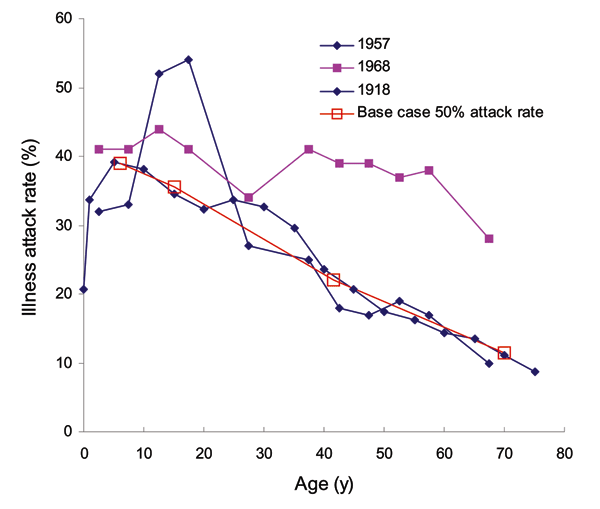Volume 12, Number 11—November 2006
Research
Targeted Social Distancing Designs for Pandemic Influenza
Figure 6

Figure 6. Comparison of simulated age class–specific illness attack rates with past pandemics. Simulated illness attack rates (half the infectious attack rate) for the unmitigated base case are close to those found in studies of historic pandemics in 1957 (19), 1968 (20), and 1918 (21). Notable differences are the 1968 Hong Kong flu, which had less effect on youth and 1957–58 Asian flu, which had greater effect; however, historic data are inherently uncertain. Closer correspondence to either of these 2 cases could be achieved through changes in IA or SA or modification of the underlying social contact network (see Results) because the network was likely different from that of a small town of today.
References
- World Health Organization. Avian influenza frequently asked questions. Geneva: The Organization; 2005.
- US Homeland Security Council. National strategy for pandemic influenza: implementation plan. Washington: US Department of Homeland Security; 2006.
- US Department of Health and Human Services. Pandemic influenza plan HHS. Washington: The Department; 2005.
- Glass RJ, Glass LM, Beyeler WE. Local mitigation strategies for pandemic influenza: prepared for the Department of Homeland Security under the National Infrastructure Simulation and Analysis Center. Report no. SAND2005–7955J. Washington: Department of Homeland Security; 2005.
- Watts DJ, Strogatz SH. Collective dynamics of 'small-world' networks. Nature. 1998;393:440–2. DOIPubMedGoogle Scholar
- Palla G, Deranyi I, Farkas I, Vicsek T. Uncovering the overlapping community structure of complex networks in nature and society. Nature. 2005;435:814–8. DOIPubMedGoogle Scholar
- Newman ME, Park J. Why social networks are different from other types of networks. Phys Rev E Stat Nonlin Soft Matter Phys. 2003;68:036122. DOIPubMedGoogle Scholar
- US Census Bureau. United States Census 2000. Washington: The Bureau; 2000.
- Ferguson NM, Cummings DA, Fraser C, Cajka JC, Cooley PC, Burke DS. Strategies for mitigating an influenza pandemic. Nature. 2006;442:448–52. DOIPubMedGoogle Scholar
- Ferguson NM, Cummings DA, Cauchemez S, Fraser C, Riley S, Meeyai A, Strategies for containing an emerging influenza pandemic in Southeast Asia. Nature. 2005;437:209–14. DOIPubMedGoogle Scholar
- Longini IM, Halloran ME, Nizam A, Yang Y. Containing pandemic influenza with antiviral agents. Am J Epidemiol. 2004;159:623–33. DOIPubMedGoogle Scholar
- Longini IM, Nizam A, Xu SF, Ungchusak K, Hanshaoworakul W, Cummings DA, Containing pandemic influenza at the source. Science. 2005;309:1083–7. DOIPubMedGoogle Scholar
- Germann TC, Kadau K, Longini IM, Macken CA. Mitigation strategies for pandemic influenza in the United States. Proc Natl Acad Sci U S A. 2006;103:5935–40. DOIPubMedGoogle Scholar
- Hayden FG, Fritz R, Lobo MC, Alvord W, Strober W, Straus SE. Local and systemic cytokine responses during experimental human influenza A virus infection: relation to symptom formation and host defense. J Clin Invest. 1998;101:643–9. DOIPubMedGoogle Scholar
- Cauchemez S, Carrat F, Viboud C, Valleron AJ, Boelle PY. Bayesian MCMC approach to study transmission of influenza: application to household longitudinal data. Stat Med. 2004;23:3469–87. DOIPubMedGoogle Scholar
- Viboud C, Boelle PY, Cauchemez S, Lavenu A, Valleron AJ, Flahault A, Risk factors of influenza transmission in households. Br J Gen Pract. 2004;54:684–9.PubMedGoogle Scholar
- Principi N, Esposito S, Gasparini R, Marchisio P, Crovari P; Flu-Flu Study Group. Burden of influenza in healthy children and their households. Arch Dis Child. 2004;89:1002–7. DOIPubMedGoogle Scholar
- Chin TD, Foley JF, Doto IL, Gravelle CR, Weston J. Morbidity and mortality characteristics of Asian strain influenza. Public Health Rep. 1960;75:148–58. DOIPubMedGoogle Scholar
- Davis LE, Caldwell GG, Lynch RE, Bailey RE, Chin TD. Hong-Kong Influenza: the epidemiologic features of a high school family study analyzed and compared with a similar study during the 1957 Asian influenza epidemic. Am J Epidemiol. 1970;92:240–7.PubMedGoogle Scholar
- Glezen WP. Emerging infections: pandemic influenza. Epidemiol Rev. 1996;18:64–76.PubMedGoogle Scholar
- Centers for Disease Control and Prevention. Death rates for selected causes by 10–year age groups, race, and sex: death registration states. Tables 1900–39. Atlanta: The Centers; 2005.
Page created: October 14, 2011
Page updated: October 14, 2011
Page reviewed: October 14, 2011
The conclusions, findings, and opinions expressed by authors contributing to this journal do not necessarily reflect the official position of the U.S. Department of Health and Human Services, the Public Health Service, the Centers for Disease Control and Prevention, or the authors' affiliated institutions. Use of trade names is for identification only and does not imply endorsement by any of the groups named above.